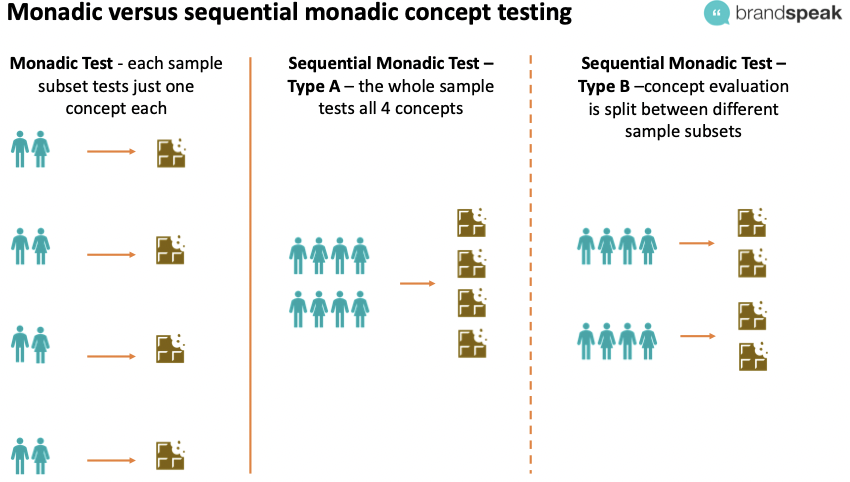What is monadic testing? How to use it to your advantage

Feedback from consumers is crucial.
Whether you work in marketing, product development, or sales, you can’t improve without feedback. But the type of feedback you get matters just as much. Because not all feedback is created equal.
For example: when a customer is trying out a whole range of perfumes at once in a store that already smells of bubblegum, the feedback on the scents you sell is somewhat useless. The solution to that is monadic testing: a market research approach in which you show your audience concepts in isolation. That way, you get focused, unfiltered feedback on that specific idea—nothing else is competing for their attention.
But what if you need to know what they think about multiple concepts? That’s what sequential monadic testing is for. It’s similar, but here, you test one concept after another with the same audience, giving you a way to compare reactions while still keeping the feedback clean and focused.
Of course, (sequential) monadic testing applies to much more than just perfume, cheese or wine. You can use it for digital products, in retail, and anywhere else where feedback is key. And the best thing? You can do it at scale, with Attest. Let’s explore what it is, and how you can use it to your benefit.
What is a monadic test?
A monadic test is a method used in market analysis where you present only one concept or product idea at a time to respondents. The goal is to get their honest reaction on that single concept without other ideas clouding their judgment or having them compare it to other options they’re seeing. By isolating a single concept, you learn how well it actually resonates with your audience, without any outside influences muddying the waters. Respondents won’t put it on a scale, but give focused feedback.
Monadic testing vs. sequential monadic testing
If you need to test more concepts than one, but still want uncluttered, unbiased feedback, you can use sequential monadic testing. The difference between monadic testing and sequential monadic testing is in how you present your concepts to your audience.
In monadic testing, respondents see only one concept in isolation. This eliminates the influence of other concepts.
With sequential monadic testing you can test multiple concepts one after the other with the same group of people.
This method is perfect for comparison testing because it lets you see how different ideas stack up against each other in real time.
Pro tip: Keep in mind that with sequential monadic testing there’s a slight risk of order bias, meaning the sequence in which concepts are presented can affect the feedback. Still, sequential monadic tests are incredibly useful when you need to test several ideas with fewer respondents.
Both methods have their strengths, but your choice depends on what you’re trying to achieve, and what needs testing. If you’re looking for in-depth feedback on a single idea, monadic tests are your best bet. But if you need to understand how different concepts compare directly, sequential monadic tests are the way to go.

The benefits of monadic testing
Market researchers, product designers, data-driven marketers: they all love monadic testing.
Whether you’re trying to refine products, messages, or packaging, it’s one of the more clean ways of getting data to support your ideas and guide next steps.
Here’s why this method is so effective:
1. Clarity: Understanding your concept without distractions
One of the most benefits of monadic tests is the level of clarity they provide.
When your respondents are shown just one concept – whether it’s a product idea, an advertisement, or a value proposition – they focus solely on that idea without being influenced by comparisons. Because when you’d show even only two concepts at a time, people will automatically start comparing them. Which is not always what you want.
You’ll get feedback that reflects the true perception or first impression of the concept. You’re not left wondering which part of a comparison swayed the response; you get a clear, unambiguous read on what your audience really thinks.
2. Predictability: Consistent results with fewer surprises
In monadic testing, each respondent evaluates a single concept in a vacuum, free from the influence of other concepts.
This means you’re more likely to increase the predictability of your results. Now, why would you want that? It’s (fairly) simple: when there are fewer variables at play, the data you gather is more consistent and reliable. This allows you to forecast outcomes with a lot more accuracy.
For consumer brands making high-stakes decisions – like whether to greenlight a new product or spend money on a daring campaign – this predictability is invaluable in making confident decisions, and getting stakeholders on board.
3. Reliability: Minimizing bias for more accurate insights
Reliability in market research hinges on eliminating biases, and monadic tests are great at exactly that.
By showing respondents only one concept, you minimize the risk of order bias and interaction effects – factors that can skew the results in comparison testing methods.
With monadic testing, the feedback is purely about the concept itself, which often leads to more accurate insights that you can trust.
4. Cost-effectiveness: Maximizing ROI in the long run
While monadic testing typically requires a larger sample size compared to other methods, it’s more cost-effective in the long run.
The reason? The data you collect is highly focused and actionable, reducing the need for repeated tests.
This also allows you to make informed decisions faster. In other words, if you do monadic testing right, it can give you all the benefits of qualitative market research: better resource allocation, quicker time to market, and ultimately, a higher return on investment.
5. In-depth insights: taking it to the next level
Monadic testing is a great place to start if you want to go into the deep end with your audience.
Because respondents in a monadic test focus entirely on one idea, you get clear inspiration for asking more detailed follow-up questions and qualitative questions. This can give you a richer understanding of your concept’s strengths and weaknesses, even the ones your team may have not seen before.
For more on the benefits of consumer research, check out this article.
Types of monadic concept testing
Monadic concept testing is more versatile than you may think. There are several variations you can choose from, depending on your specific goals and resources.
We’ll have a look at how each approach offers its own advantages, so you can tailor your testing strategy to gather the most relevant and actionable insights.
1. Split cell testing
With split cell testing, you divide your audience into separate groups, with each group exposed to only one concept.
This method is great for testing multiple concepts without letting the feedback from one group influence another. You get to see how different ideas perform in isolation, ensuring that the feedback you receive is purely about the concept in question.
This approach is ideal for testing multiple concepts simultaneously while maintaining the clarity and focus that monadic tests are known for.
2. Partially sequential testing
Partially sequential testing gives you the best of both worlds. It strikes a balance between monadic and sequential monadic testing.
In this hybrid approach, respondents might be shown one concept first, followed by others after a break or in a different session.
The aim of this method is to reduce order bias – the tendency for earlier concepts to be remembered more favorably – while still allowing some level of comparison between ideas. Use this when you want to do consumer research that compares concepts but are concerned about the potential influence of seeing them back-to-back, for instance with concepts that are strikingly similar.
3. Sequential monadic testing
If you do want to compare opinions, you can use a sequential monadic test.
This method of concept testing involves showing the same respondents multiple concepts, one after the other. When you need to understand how concepts stack up against each other in the same respondent’s mind, this is the way to go.
But while it offers valuable comparison insights, be mindful of order bias, as the sequence in which concepts are shown can impact how they are perceived.
Explore how Attest’s creative testing services can support your market research efforts.
How to set up a monadic test
Below you’ll find what steps to keep in mind in general when setting up a monadic test, and how Attest makes it even easier:
Step 1: Define your objective
Every other step in the process will be influenced by the goal of your monadic concept testing.
What is it you want to learn, and what do you want to do with that information? Are you testing a new product idea? Trying to refine your value proposition? Is this to convince stakeholders, or to give your team fresh ideas? The more clearly defined your objective, the more useful the outcome of the research will be.
Step 2: Select your concepts
Choose the concepts or ideas you want to test.
Whether it’s a product concept, an ad headline, or a landing page design, make sure each is clear and well-defined. Know what limitations each concept has, depending on the stage of development it is in. You should either communicate this to your target audience, or keep it in mind when analyzing their feedback.
Step 3: Design your survey
Time to create a monadic survey design or sequential monadic test.
Your survey should include follow-up questions that dive into why respondents feel the way they do about the concept. With Attest, you can easily do this. Just check our tutorial here.
Step 4: Choose your sample size
Determine your sample size based on your research needs.
A larger sample can provide more reliable data, but it’s essential to balance size with practicality and cost. For comparison testing or clean monadic concept testing, the ideal sample size can differ.
Step 5: Analyze the results (and take action)
Once your monadic test is complete, analyze the data to identify the strengths and weaknesses of each concept.
Look for trends in the responses that can inform your next steps, based on your initial research goals.
For more detailed insights on setting up sequential monadic tests or split cell monadic testing, check out our guide on gathering consumer insights.
Tell us what you think of this article by leaving a comment on LinkedIn.
Or share it on:
